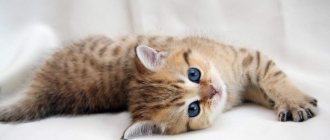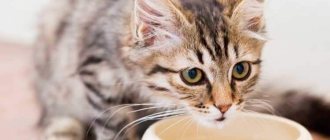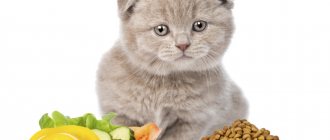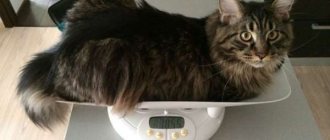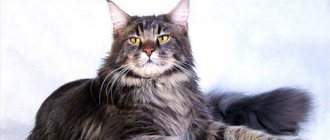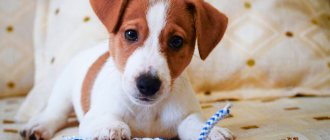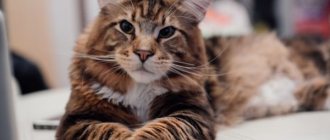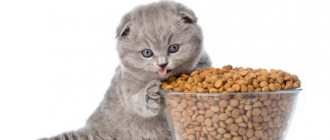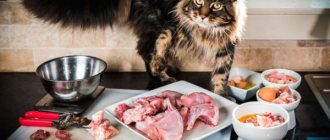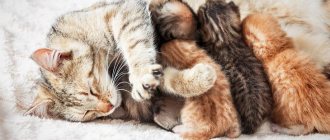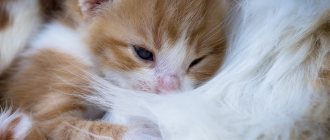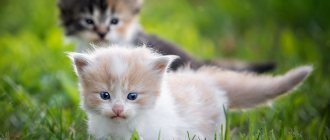The diet of this breed of domestic cat must be carefully selected by its owner. Below we will consider various diets, which, along with natural food, contain mixed nutrition and special premium nutritious food.
The creation of such diets is entirely aimed at the proper distribution of nutrition, which is the health and beauty of the cat.
Content
- Basics of a healthy diet
- Natural nutrition Healthy food
- Junk food
- Balanced composition and daily requirement
- "Kunya porridge"
- Dry food
- Age factor
- Feeding with natural products
Animal growth
Maine Coon mixed breed - a mixture with a regular cat
Up to one year of age, kittens develop quite rapidly. By three months, the baby already exceeds the performance of some adult cats of ordinary breeds. In general, the size of a pet depends on many factors.
Important! You should not be upset if the animal does not meet the development standards, but you should still be careful. There is always the possibility that the breeder sold a crossbreed instead of a purebred Maine Coon. When choosing an animal for your family, it is best to contact an official nursery.
Height
Basics of a healthy diet
The main principle that cannot be neglected: food prepared for family members is not suitable for feeding a four-legged friend!
This is due to:
- characteristics of the animal’s digestive system;
- a specific set of enzymes;
- the difference in vitamin-mineral, energy needs of the human and cat body.
Food “from the table” is poorly digested by pets, causing gastrointestinal disorders, liver and kidney diseases, and developmental disorders.
Before creating a diet for your ward, you should choose one of two feeding options. Suitable daily menu:
- Natural food prepared taking into account the physiological characteristics of the animal. The main ingredient in cat dishes is lean meat.
- Ready food. It has a balanced composition and is available in dry and wet form. Sold in pet stores and special departments of supermarkets.
Proper nutrition contributes to:
- normal formation of the skeleton and muscular system;
- good condition of teeth, claws, coat;
- strengthening immunity, preventing diseases;
- establishing contact with the owner;
- increasing life expectancy.
Bad associations
There is another very interesting feature of cats, closely related to the previous one. Cats not only try to avoid dangers to their health, but even “analyze” their causes. When an animal feels unwell some time after eating, even if the reason is not food at all, it can associate the deterioration in its health with the specific type of food eaten. A similar mechanism exists in humans. If you have ever been poisoned by something unknown, then you know very well that, remembering everything you have eaten during the day, you will definitely come across a product that will give you an unpleasant feeling of nausea. A person usually concludes that this is what poisoned him. To check their guess, people can use the complex logic of their thinking, but a cat is deprived of such abilities, and therefore associates a sharp deterioration in health with the last action it performed, and refuses food, often forever. After all, these animals have excellent memory - this is also one of their features.
Natural nutrition
You can feed a Maine Coon with natural food only if the owner has time to prepare special dishes.
Healthy food
The table provides a list of foods that should be included in the Maine Coon’s diet:
| The product's name | Useful composition | Feeding features |
| Meat: beef, chicken, turkey (without skin), rabbit, lamb (lean), horse meat. | Proteins (16–20%); vitamins A, D, E, H, PP, group B; calcium, magnesium, potassium, sodium, phosphorus, iron, chlorine. | You can give it boiled or raw, after keeping it in the freezer for 3-5 days. Sometimes it is allowed to diversify the menu with low-fat meat broth. |
| By-products: liver (in small quantities), heart, tripe, udder, stomach. | Proteins; vitamins A, E, PP, group B; calcium, magnesium, potassium, iron, copper, zinc. | Served boiled. |
| Vegetables: carrots, zucchini, pumpkin, cauliflower. | Vitamins A, B1, B2, C, D, E, K, PP; calcium, magnesium, phosphorus, potassium, sodium, iron, manganese, copper, zinc. | Can be given raw, boiled, baked. |
| Greens: parsley, dill, lettuce. | Vitamins A, B1, B2, C, E, K, PP; calcium, potassium, phosphorus, iron. | Add to meat and vegetable dishes. |
| Porridge: oatmeal, rice, buckwheat. | Vitamins B, E, K, PP; calcium, phosphorus, potassium, magnesium, sodium, sulfur, iron, zinc. | Serve porridges cooked in water or low-fat meat broth with finely chopped meat and fresh herbs. |
| Sea fish: hake, pollock, lemonema, etc. | Proteins; vitamins A, B, C, D, E, K; phosphorus, potassium, sodium, magnesium, calcium, iron, sulfur, chlorine, manganese, copper, iodine, zinc, fluorine. | Offer boiled no more than 1-2 times a week. |
| Eggs: chicken, quail. | Proteins; vitamins A, groups B, D, E, K, PP; calcium, potassium, magnesium, sodium, phosphorus, iron, copper, manganese, selenium, zinc. | Serve chicken eggs (yolks) hard-boiled. Quail - can be given whole raw. |
| Fermented milk products (low-fat): kefir, yogurt, cottage cheese, fermented baked milk, acidophilus, Varenets. | Beneficial bacteria; vitamins A, group B, C, D, D3, E, K, PP; calcium, potassium, phosphorus, magnesium, sodium, selenium. | Offer fresh product at room temperature. |
| Vegetable oil: sunflower, olive, flaxseed | Fats; vitamins: A, group B, D, E, K; potassium, calcium, phosphorus, sodium, omega-6, omega-9 fatty acids. | Add ½ tsp to porridge and vegetable dishes. for one serving. |
Junk food
The table provides a list of foods that should not be included in a cat’s diet:
| The product's name | Why should you not include it in your diet? |
| Fatty meat: pork, duck, goose | Causes functional disorders of the stomach and intestines. Frequent feeding of this product can cause severe disturbances in the cat’s digestive system and lead to the death of the animal. |
| Bones | Injury to the organs of the gastrointestinal tract. |
| Milk | Causes indigestion. |
| Potato | When boiled, it is a useless product. Raw potatoes are harmful due to their high starch content. |
| Tomatoes and eggplants | They cause stomach pain due to the presence of alkaloids in vegetables. |
| Beans | May cause bloating and flatulence. |
| Onion and garlic | They are a source of disulfides - substances that destroy leukocytes |
| Mushrooms | Difficult to digest and toxic to the cat's body. |
| Avocado | Causes gastrointestinal disorders due to the content of persin, which is toxic to Maine Coons. |
| Nuts | High phosphorus content contributes to impaired hematopoiesis, calcium loss, and the development of liver and kidney diseases. |
| Pasta | May cause gastrointestinal colic |
| Flour products | Causes bloating and diarrhea. |
| Sweets | Promotes obesity, metabolic disorders, and tooth decay. |
| Salty dishes | They form an electrolytic imbalance, increasing the risk of diseases of the heart, digestion, and muscular system. |
Foods that should be given to your Maine Coon with caution and in limited quantities:
- Fish. Feeding fish dishes more than 2 times a week can cause diseases of the genitourinary system.
- Eggs. Contain a large amount of cholesterol. Frequent use of this product during feeding is fraught with disorders of the digestive system and gall bladder. Raw eggs should not be given due to possible salmonellosis infection.
- Carrot. Carotene present in the composition contributes to the appearance of a yellow tint in the coat of light-colored cats.
Balanced composition and daily requirement
The goal of proper nutrition is to provide the living body with the necessary substances and calories, avoiding pathological deviations in body weight.
The Maine Coon should be fed according to established standards: for a cat to grow large, 60 kcal and 10 g of protein are required per 1 kg of weight. The composition of natural food must correspond to the following indicators (per 100 g):
- protein – 20–45%;
- fats – 10–30%;
- fiber – 2%;
- energy value – 300–400 kcal.
A Maine Coon that has reached the size of an ordinary cat eats approximately 250 g per day. Accordingly, the number of main products offered during the day will be as follows:
- meat (or fish) – 60–120 g;
- cereals – 10–20 g;
- vegetables – 20–50 g;
- fermented milk products – 20–60 g.
When the Maine Coon finally grows up, the amount of food will need to be increased by 1.5–2 times.
An adult Maine Coon should be properly fed 2 times a day, dividing the daily portion into 2 parts. It is necessary to ensure that there is always a bowl of purified drinking water in the cat’s territory (boiling is not recommended).
"Kunya porridge"
One of the options for natural balanced food for Maine Coons is “kunya porridge”. The general composition of this dish is as follows:
- Meat products – 80%.
- Additives – 20%.
Meat products:
- meat (beef, turkey, chicken, rabbit);
- offal (heart, liver, stomach, tripe, udder, lung).
Additives:
- fermented milk products (kefir, yogurt, yogurt, cottage cheese, cheese);
- chicken eggs (yolks);
- vegetables (carrots, zucchini, cauliflower, pumpkin);
- greens (parsley, dill, lettuce, kelp);
- vegetable oil (sunflower, olive, flaxseed).
Based on these products, you can create various cooking recipes. One of them is presented here.
Ingredients:
- beef – 1 kg;
- beef liver – 500 g;
- beef kidneys – 500 g;
- veal heart – 500 g;
- light veal – 500 g;
- turkey fillet – 1 kg;
- chicken necks – 1 kg;
- chicken stomachs – 500 g;
- chicken necks – 1 kg;
- carrots – 4 pcs;
- zucchini (or pumpkin) – 1 kg;
- wheat bran – 500 g;
- kelp – 50 g.
Cooking method:
Cut the beef and turkey fillet into small pieces, and grind the offal in a meat grinder. Add the chopped herbs and mix everything. Divide the resulting mixture into bags and place in the freezer for 3-4 days. Before serving, add kefir or yogurt (without additives).
What not to feed
Often, Maine Coon owners, wanting to pamper their pets, try to feed them something tasty. Some products can cause allergic reactions in cats and also negatively affect their health and well-being. To prevent negative consequences, it is not recommended to feed Maine Coons the following foods:
- viscous porridge with milk;
- buns, pies, fast food;
- candies, cakes and other sweets;
- potatoes in any form, especially fried;
- spicy, hot, salty, smoked products;
- peas, beans;
- whole cow's milk;
- sharp tubular bones, fish with a lot of bones.
In small quantities, it is allowed to give Maine Coons refined vegetable oil, chopped chicken and beef liver.
The main rules when creating a menu for a Maine Coon are compliance with the recommended ratio of proteins, fats and carbohydrates, as well as the use of only foods approved for feeding. By adhering to these principles, even a novice breeder will be able to provide his pet with proper nutrition, which will fill the cat with energy and health.
Video: how to feed a Maine Coon and what you can give.
Vitamins and minerals
A natural diet does not always meet the standards of a balanced diet. To compensate for the lack of active substances, it is recommended to use vitamin and mineral supplements. The need for them is increasing:
- during a period of active growth;
- during illness;
- under stress;
- during the molting period;
- during pregnancy and feeding;
- in the autumn-spring season.
A veterinarian will help you choose a suitable complex, taking into account the individual characteristics of the animal. To prescribe certain additives, the following factors are taken into account:
- pet's age;
- appearance;
- emotional condition;
- behavioral characteristics;
- results of biochemical tests.
The table contains general recommendations for the use of vitamin and mineral supplements:
| What is the purpose of the additive? | What medications are needed |
| For proper growth and development (up to 6 months) | Complexes with high calcium content. |
| For bone strength | Calcium and phosphorus supplements. |
| For the beauty of wool | Preparations containing vitamins A, D, group B and calcium. |
| To improve digestion | Vitamin complexes with taurine. |
| To improve visual acuity | Vitamin complexes with taurine. |
| For a successful pregnancy | Supplements with calcium, phosphorus, iron, vitamins A, E, D, group B. Special preparations based on spirulina (a rich source of folic acid). |
| For well-being in old age | Preparations containing calcium. Vitamin B6 (stimulates brain function). Herbal supplement based on ginkgo biloba. |
| For the prevention of urolithiasis in castrated animals | Multivitamins with taurine and calcium. |
There are various forms of vitamin and mineral supplements:
- pills;
- capsules;
- pastes;
- powders.
Many vitamin products have a pleasant taste, so cats eat them with great pleasure. If the pet refuses to take the drug in its pure form, it is added to the food (the tablets are pre-crushed).
Age of castration
Representatives of this breed are ready to breed from the age of 8-10 months. It is for this reason that if the owner of the animal does not plan further breeding, it is best to carry out castration or sterilization.
The need for surgery is determined by the instinct of reproduction. If this is not done, the pet will experience physical discomfort. The male begins to mark the territory by releasing a strong-smelling substance. Cats roll around on the floor, making loud sounds that are unpleasant to human hearing. In addition, this can subsequently lead to the development of various diseases.
Feeding with prepared food
If you have a shortage of free time and for a more balanced diet, you can use ready-made food. They contain all the necessary substances in optimal proportions. The main condition for the successful use of an industrial product is its compliance with high quality. This is the feed class:
- "premium";
- "super-premium";
- "holistic".
According to veterinary standards, the quantitative ratio of nutrients in the finished product should be as follows:
- proteins – no less than 26%;
- fats – 9%.
High-quality food contains the following components:
- natural meat (up to 70%);
- offal;
- herbal supplements (herbs);
- cereals (absent in some foods).
In order not to make a mistake in your choice, you need to buy food in original packaging. The product is of high quality if the information on the box or package meets regulatory requirements:
- the first in the list of ingredients is meat indicating its variety (beef, turkey, chicken, rabbit);
- the product contains no artificial preservatives;
- products o, “Superpremium”, “Holistic”.
Depending on the consistency, industrial feeds are divided into 2 types:
- dry;
- wet.
Dry food
Advantages:
- Has a long shelf life without special conditions.
- Can stay in the cat's bowl for 24 hours.
- Reduces the likelihood of tartar formation.
- Indispensable when traveling.
- Costs less than wet.
One of the disadvantages of dry food is the lack of moisture, so when using it, you should provide your pet with the necessary amount of water. The daily fluid intake corresponds to 25 ml per 1 kg of weight. The ratio of the amount of dry food and water is determined by the proportion 1:3.
Wet food
Available in the form of pates and jellies. Contains up to 80% water. Has its advantages:
- Better absorbed by the cat's body.
- It is more nutritious and high in calories.
- Eaten by cats with great appetite.
Flaws:
- Overeating contributes to excess weight gain.
- Stored in the refrigerator.
- Once opened, the can quickly deteriorates.
If both types of ready-made food are present in the Maine Coon’s diet, it is advisable to adhere to the following ratio:
- dry food – 75%;
- wet food – 25%.
When using an industrial product, the following rules should be observed:
- Choose food for Maine Coons in accordance with the age, weight, and energy expenditure of the pet.
- Follow the dosage specified by the manufacturer.
- Do not add vitamins and minerals to the finished product.
- Do not mix food from different brands.
- Make sure there is fresh water in the bowl.
Veterinarians do not recommend combining the use of a finished product with a natural type of feeding.
This combination can cause:
- vitamin and mineral imbalance;
- metabolic disease;
- digestive disorders;
- weight gain or loss.
The best food for Maine Coon
The table shows the TOP 5 (best industrial feed):
| Name of food | Class | a brief description of |
| 1. Wellness® Indoor Health for Adult Cat (USA) | "Holistic" | Protein content – 30%, fat – 12%. Ingredients: chicken meat and liver, herring flour, cereals. Enriched with vitamins E, B2, B3, B6, B12, D3, folic acid, calcium, copper. Contains chondroitin and glucosamine (for joint health). |
| 2. Bosch Sanabelle Grande (Germany) | "Super-premium" | Protein content – 31%, fat – 20%. Ingredients: poultry meat and liver, salmon, cereals, beet pulp, blueberries and cranberries, brewer's yeast, calendula extract, chicory root; chondroitin and glucosamine. |
| 3. Eukanuba Mature Care Formula for Cats (USA) | "Premium" | Protein content – 36%, fat – 17%. Ingredients: chicken meat and offal, fish oil, egg powder, beet pulp, corn flour. As additives - vitamins A, C, E, B2, B3, B12, D3, folic acid, calcium, zinc, tocopherols. The food strengthens the immune system, improves digestion and wool quality. |
| 4. ProNature 30 Adult for Cats (Canada) | "Premium" | Protein content – 30%, fat – 18%. Ingredients: chicken meal, chicken fat, beet pulp, cereals, cranberries. Additives: calcium, lecithin, tocopherols, natural fibers; Yucca Schidigera extract. The product improves immunity, slows down the aging process, and helps remove hair from the digestive tract. |
| 5. Hill's Nature's Hill's "Premium" Nature's Best™ With Real Chicken Adult Cat (USA) | "Premium" | Protein content – 30%, fat – 19%. Ingredients: chicken meat and liver, egg powder, cereals, beet pulp, carrots, peas, animal fat. Includes 25 vitamin and mineral supplements. Active components include iodine, copper, biotin, folic acid. The food has a beneficial effect on the immune system. |
Nutritional features depending on the circumstances
When preparing a diet for your pet, the following factors should be taken into account:
- age of the animal;
- health status;
- history of sterilization (castration) operations;
- for cats – bearing and feeding offspring.
Age factor
The composition and quantity of feed, diet must be adjusted in accordance with age needs. A growing organism needs “building” material, the source of which is food and vitamin and mineral supplements.
Up to 4 months, a Maine Coon kitten should be fed small portions 5-6 times a day. Gradually, the number of feedings decreases and by 12 months the growing baby switches to 2 meals a day.
By this time, the composition of the feed should also change. A mature body does not experience the same needs as during the period of growth.
Therefore, you should not offer a mature cat food intended for kittens, and babies should not be fed “adult” food.
Nutrition during illness
Despite the fact that representatives of the breed are distinguished by their strong physique and endurance, they may experience health problems due to unfortunate heredity.
The table shows diseases characteristic of the Maine Coon breed:
| Disease | Recommendations for treatment and prevention |
| Urolithiasis disease | To prevent the disease, it is necessary to exclude fish and economy-class food from the diet, and ensure an optimal drinking regime. For therapeutic and preventive purposes, veterinary foods from the Urinary series (Royal Canin Urinary S/O, Purina Pro Plan Urinary, Eukanuba Veterinary Diets Urinary Oxalate) should be used. |
| Joint pathology | For the purpose of prevention, preference should be given to high-quality feed, which includes the medicinal substances chondroitin and glucosamine. To treat the disease, in case of obesity with increased stress on the joints, the pet should be switched to veterinary feed products (Eukanuba Veterinary Diets Urinary Struvite for Cats Dry, Hill's Feline j/d.) |
| Hypertrophic cardiomyopathy | The animal must be under the supervision of a veterinarian. It is recommended to reduce the amount of salt in the diet. |
Feeding castrated (sterilized) animals
Removal of testes in cats (ovaries in cats) affects their character and behavior. This is due to hormonal changes in the body. Animals become calmer, move less, and rest more.
The composition of the feed and diet for castrated (sterilized) individuals should be selected in such a way as to minimize the likelihood of obesity. To prevent urolithiasis, it is necessary to choose feed with a reduced content of phosphorus and magnesium.
The volume of liquid drunk should be 3 times the amount of dry food eaten. In case of insufficient consumption, the following methods can be taken:
- offer food soaked in water;
- switch partially or completely to wet food;
- switch your pet to home-cooked meals.
Nutrition for pregnant and lactating cats
If the expectant mother is accustomed to eating ready-made food, she should not be switched to natural food. In this case it is necessary:
- switch to special super premium food for pregnant and lactating cats ;
- introduce kitten food (dry and wet) into the diet.
If your cat ate natural foods before pregnancy, you need to adjust its menu. The following products should be excluded:
- fish (increases the load on the kidneys);
- vegetables that can cause intestinal disorders (cabbage, beets);
- products containing spices.
Milk must be included in the diet.
In the first trimester, the cat should be fed 2 times a day. In the middle of pregnancy - 3 times, increasing the daily norm by 50%. On the eve of birth, feeding should be frequent (5-6 times a day) using small portions.
With a natural diet, pregnant and lactating cats need special vitamin and mineral supplements. Any drug must be prescribed by a veterinarian.
A nursing cat is also given fractional meals, thanks to which it is possible to avoid additional stress on the body. During lactation, the animal must consume large amounts of fluid. In addition to water, you can offer your cat milk and low-fat broth.
Food for nursing cats
After the kittens are born, nutrition remains as usual. But it needs some adjustment - due to the increase in the cat’s energy consumption. She must recover after giving birth and at the same time feed her cubs. Immediately after lambing, it is necessary to give scalded meat, more dairy products - cottage cheese, sour cream. Milk itself should not be given, as it is not absorbed by her body. You can use bone meal, vitamin and mineral supplements. It is especially worth noting that the diet must include:
- boiled eggs;
- fish;
- meat with fresh herbs.
No spices can be added. It is also necessary to provide your cat with full access to water.
Feeding Maine Coon kittens
In the first weeks of life, the only food for a kitten is mother's milk. The first complementary foods should be introduced at the end of 1 month. By this time, it is necessary to decide on the type of nutrition - based on natural products or using ready-made feed.
Feeding with natural products
The table shows feeding features according to the age of the kitten (by month):
| Age | Sample menu | Number of feedings |
| 1st month | The main food is mother's milk. If it is unavailable, a substitute must be used. Complementary foods are gradually introduced - liquid porridge, boiled scraped meat. Kefir, cottage cheese, and egg yolk are allowed in small quantities. | 8 times |
| 2nd month | Feeding with breast milk or substitute. Introducing boiled, grated vegetables into the diet with the addition of a few drops of vegetable oil. The number of porridges is being reduced. The daily portion of meat increases, which needs to be cut into thin strips. | 6 times |
| 3rd month | The menu includes almost all “adult” products: boiled lean meat, offal (no more than 3 times a week, liver - 1 time), seafood, cereals, eggs, dairy products, fruits and vegetables. | 5 times |
| 4-5 months | The composition of the diet does not change. The volume of portions is adjusted depending on the weight of the pet. | 4 times |
| 6-12 months | Eating habits are consolidated (eating certain foods in the required quantities at the prescribed time). | 3 times, after 9 months – 2 times |
If you choose a ready-made food type, you must give preference to high-quality products that are specially designed for Maine Coon kittens. The following feeds meet these requirements:
- Royal Canin Kitten Maine Coon
- Bosch Sanabell kitten
At first, dry food needs to be soaked until the kittens can chew the hard granules on their own.
How to switch to natural
If a decision is made to change the diet and feed the pet not prepared food, but natural food, the transition is smooth.
When changing the diet, veterinarians advise introducing probiotics into the cat’s menu. One of these drugs is the dietary supplement Vetom.
A pet may resist change, but the owner must be persistent and patient. The maximum limit of a hunger strike (according to owners’ reviews) is 5 days. Then the animal gives in and starts eating. There are often cases when during the day a cat turns his face away from the bowl, and at night he eats every single piece.
At first, the cat is offered only meat. If the pet begins to eat it well and there is no bowel disorder, another ingredient is introduced, followed by a third after 2-3 days. Products containing bones (chicken necks, heads) are added last.
